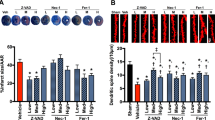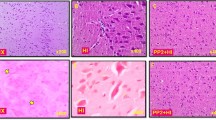Abstract
Cathepsin B, one of major lysosomal cathepsins, and JNK, a downstream component of Rho kinase (ROCK), are two families of proteases, which play an important role in ischemic cell apoptosis. However, the interrelationship between Cathepsin B and JNK in apotosis has not been examined. In the present study, rats were decapitated at 0, 2, 6, 24, 48 h of reperfusion after 2 h of middle cerebral artery occlusion (MCAO); TUNEL-positive cells appeared in the ipsilateral preoptic region during reperfusion after 2-h MCAO, and gradually increased to a peak of 24 h after reperfusion; Phospho-JNK (p-JNK) immunoreactivity, occurring after Cathepsin B expression, was gradually increased and peaked altogether with Cathepsin B at 6-h reperfusion; Fasudil (5 mg/kg, intraperitoneally), an inhibitor of ROCK, decreased the level of p-JNK and apoptotic neurons, and had no effect on cathepsin B; Immunofluorescent double labeling showed that the colocalization of cathepsin B with p-JNK appeared in the preoptic region at 2, 6, 24, 48 h of reperfusion. These findings indicate that a signal transduction pathway by ischemia–reperfusion is most likely to exist: lysosomal cathepsin B-Rho/Rho kinase pathway-JNK signaling pathway-mitochondrial-dependent intrinsic pathway.





Similar content being viewed by others
References
Seyfried D, Han Y, Zheng Z et al (1997) Cathepsin B and middle cerebral artery occlusion in the rat. J Neurosurg 87:716–723
Guicciardi ME, Miyoshi H, Bronk SF et al (2001) Cathepsin B knockout mice are resistant to tumor necrosis factor-α-mediated hepatocyte apoptosis and liver injury. Am J Pathol 159:2045–2054
Cirman T, Oresić K, Mazovec GD et al (2004) Selective disruption of lysosomes in HeLa cells triggers apoptosis mediated by cleavage of Bid by multiple papain-like lysosomal cathepsins. J Biol Chem 279:3578–3587
Caruso JA, Mathieu PA, Joiakim A et al (2006) Aryl hydrocarbon receptor modulation of tumor necrosis factor-alpha-induced apoptosis and lysosomal disruption in a hepatoma model that is caspase-8-independent. J Biol Chem 281:10954–10967
Conus S, Perozzo R, Reinheckel T et al (2008) Caspase-8 is activated by cathepsin D initiating neutrophil apoptosis during the resolution of inflammation. J Exp Med 205:685–698
Zheng L, Kågedal K, Dehvari N et al (2009) Oxidative stress induces macroautophagy of amyloid beta-protein and ensuing apoptosis. Free Radic Biol Med 46:422–429
Seyfried D, Veyna R, Han Y et al (2001) A selective cysteine protease inhibitor is non-toxic and cerebroprotective in rats undergoing transient middle cerebral artery ischemia. Brain Res 901:94–101
Tsubokawa T, Yamaguchi-Okada M, Calvert JW et al (2006) Neurovascular and neuronal protection by E64d after focal cerebral ischemia in rats. J Neurosci Res 84:832–840
Anagli J, Abounit K, Stemmer P et al (2008) Effects of cathepsins B and L inhibition on postischemic protein alterations in the brain. Biochem Biophys Res Commun 366:86–91
Cataldo AM, Paskevich PA, Kominami E et al (1991) Lysosomal hydrolases of different classes are abnormally distributed in brains of patients with Alzheimer disease. Proc Natl Acad Sci USA 88:10998–11002
Sugino T, Nozaki K, Takagi Y et al (2000) Activation of mitogen-activated protein kinasesafter transient forebrain ischemia in gerbil hippocampus. J Neurosci 20:4506–4514
Irving EA, Bamford M (2002) Role of mitogen- and stress-activated kinases in ischemic injury. J Cereb Blood Flow Metab 22:631–647
Borsello T, Clarke PG, Hirt L et al (2003) A peptide inhibitor of c-Jun N-terminal kinase protects against excitotoxicity and cerebral ischemia. Nat Med 9:1180–1186
Okuno S, Saito A, Hayashi T et al (2004) The c-Jun N-terminal protein kinase signaling pathway mediates Bax activation and subsequent neuronal apoptosis through interaction with Bim after transient focal cerebral ischemia. J Neurosci 24:7879–7887
Shi J, Wei L (2007) Rho kinase in the regulation of cell death and survival. Arch Immunol Ther Exp (Warsz) 55:61–75
Marinissen MJ, Chiariello M, Tanos T et al (2004) The small GTP-binding protein RhoA regulates c-jun by a ROCK-JNK signaling axis. Mol Cell 14:29–41
Longa EZ, Weinstein PR, Carlson S et al (1989) Reversiblemiddle cerebral artery occlusion without craniectomy in rats. Stroke 20:84–91
Garcia JH, Yoshida Y, Chen H et al (1993) Progression from ischemic injury to infarct following middle cerebral artery occlusion in the rat. Am J Pathol 142:623–635
Chaitanya GV, Babu PP (2008) Activation of calpain, cathepsin-b and caspase-3 during transient focal cerebral ischemia in rat model. Neurochem Res 33:2178–2186
Li Y, Chopp M, Jiang N et al (1995) Temporal profile of in situ DNA fragmentation after transient middle cerebral artery occlusion in the rat. J Cereb Blood Flow Metab 15:389–397
Benchoua A, Braudeau J, Reis A et al (2004) Activation of proinflammatory caspase by cathepsin B in focal cerebral ischemia. J Cereb Blood Flow Metab 24:1272–1279
Hayashi T, Sakai K-I, Sasaki C et al (2000) c-Jun N-terminal kianse (JNK)and JNK interacting protein response in rat brain after transient middle cerebral artery occlusion. Neurosci Letts 284:195–199
Wen J, Watanabe K, Ma M et al (2006) Edaravone inhibits JNK-c-Jun pathway and restores anti-oxidative defense after ischemia-reperfusion injury in aged rats. Biol Pharm Bull 29:713–718
Guicciardi ME, Deussing J, Miyoshi H (2000) Cathepsin B contributes to TNF-α–mediated hepatocyte apoptosis by promoting mitochondrial release of cytochrome c. J Clin Invest 106:1127–1137
Wei MC, Lindsten T, Mootha VK et al (2000) tBID, a membrane-targeted death ligand, oligomerizes BAK to release cytochrome c. Genes Dev 14:2060–2071
Reiners JJ Jr, Caruso JA, Mathieu P et al (2002) Release of cytochrome c and activation of pro-caspase-9 following lysosomal photodamage involves bid cleavage. Cell Death Differ 9:934–944
Boya P, Andreau K, Poncet D et al (2003) Lysosomal membrane permeabilization induces cell death in a mitochondrion-dependent fashion. J Exp Med 197:1323–1334
Furman LM, Maaty WS, Petersen LK et al (2009) Cysteine protease activation and apoptosis in Murine norovirus infection. Virol J 6:139
Tournier C, Hess P, Yang DD et al (2000) Requirement of JNK for stress-induced activation of the cytochrome c-mediated death pathway. Science 288:870–874
Eskes R, Desagher S, Antonsson B et al (2000) Bid induces the oligomerization and insertion of Bax into the outer mitochondrial membrane. Mol Cell Biol 20:929–935
Lei K, Nimnual A, Zong W-X et al (2002) The Bax subfamily of Bcl2-related proteins is essential for apoptotic signal transduction by c-Jun NH2-terminal kinase. Mol Cell Biol 22:4929–4942
Lei K, Davis RJ et al (2003) JNK phosphorylation of Bim-related members of the Bcl2 family induces Bax-dependent apoptosis. Proc Natl Acad Sci USA 100:2432–2437
Kuwana T, Bouchier-Hayes L, Chipuk JE, Newmeyer DD et al (2005) BH3 domains of BH3-only proteins differentially regulate Bax-mediated mitochondrial membrane permeabilization both directly and indirectly. Mol Cell 17:525–535
Wang YX, Martin-McNulty B, da Cunha V et al (2005) Fasudil, a Rho-kinase inhibitor, attenuates angiotensin II-induced abdominal aortic aneurysm in apolipoprotein E-deficient mice by inhibiting apoptosis and proteolysis. Circulation 111:2219–2226
Petrache I, Crow MT, Neuss M et al (2003) Central involvement of Rho family GTPases in TNF-alpha-mediated bovine pulmonary endothelial cell apoptosis. Biochem Biophys Res Commun 306:244–249
Wang XT, Pei DS, Xu J et al (2007) Opposing effects of Bad phosphorylation at two distinct sites by Akt1 and JNK1/2 on ischemic brain injury. Cell Signal 19:1844–1856
Ying H, Biroc SL, Li WW et al (2006) The Rho kinase inhibitor fasudil inhibits tumor progression in human and rat tumor models. Mol Cancer Ther 5:2158–2164
Ikeda H, Kume Y, Tejima K et al (2007) Rho-kinase inhibitor prevents hepatocyte damage in acute liver injury induced by carbon tetrachloride in rats. Am J Physiol Gastrointest Liver Physiol 293:G911–G917
Taoufiq Z, Gay F, Balvanyos J et al (2008) Rho kinase inhibition in severe malaria: thwarting parasite-induced collateral damage to endothelia. J Infect Dis 197:1062–1073
Olson MF (2008) Applications for ROCK kinase inhibition. Curr Opin Cell Biol 20:242–248
Arita R, Hata Y, Nakao S et al (2009) Rho kinase inhibition by fasudil ameliorates diabetes-induced microvascular damage. Diabetes 58:215–226
Yamashima T, Tonchev AB, Tsukada T et al (2003) Sustained calpain activation is associated with lysosomal rupture executes necrosis of the postischemic CA1 neurons in primates. Hippocampus 13:791–800
Sahara S, Yamashima T (2010) Calpain-mediated Hsp70.1 cleavage in hippocampal CA1 neuronal death. Biochem Biophys Res Commun 393:806–811
Yamashima T (2011) Hsp70.1 and related lysosomal factors for necrotic neuronal death. J Neurochem. doi:10.1111/j.1471-4159.2011.07596.x
Yap YW, Whiteman M, Bay BH et al (2006) Hypochlorous acid induces apoptosis of cultured cortical neurons through activation of calpains and rupture of lysosomes. J Neurochem 98:1597–1609
Liu L, Xing D, Chen WR (2009) Micro-calpain regulates caspase-dependent and apoptosis inducing factor-mediated caspase-independent apoptotic pathways in cisplatin-induced apoptosis. Int J Cancer 125:2757–2766
Nozaki K, Das A, Ray SK et al (2010) Calpain inhibition attenuates intracellular changes in muscle cells in response to extracellular inflammatory stimulation. Exp Neurol 225:430–435
Acknowledgments
This study was subsidized by University of South China, the First Hospital of Changsha and Changsha Institute of Neurology. We would like to extend our great gratitude to teaches from Neurology Lab of Xiangya Hospital of Central South University for their help.
Author information
Authors and Affiliations
Corresponding author
Additional information
Z. G. Li and Z. B. Zhang contributed equally to this work.
Rights and permissions
About this article
Cite this article
Zhang, Z.B., Li, Z.G. Cathepsin B and Phospo-JNK in Relation to Ongoing Apoptosis after Transient Focal Cerebral Ischemia in the Rat. Neurochem Res 37, 948–957 (2012). https://doi.org/10.1007/s11064-011-0687-8
Received:
Revised:
Accepted:
Published:
Issue Date:
DOI: https://doi.org/10.1007/s11064-011-0687-8




